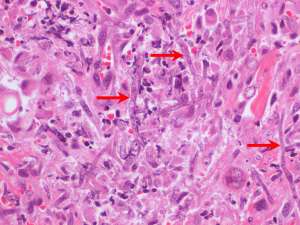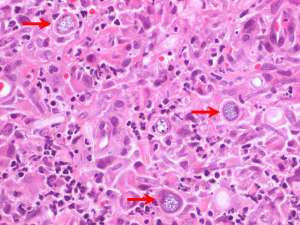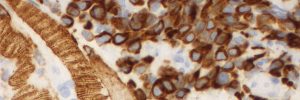Alternaria spp. infection in an immunocompromised dog
A 2-year-old male Labrador was being treated with immunosuppressive doses of prednisolone and azothioprine for immune-mediated panuveitis when he developed ulcerative cutaneous lesions. The following are H&E (x400) sections from the ulcerated skin that was biopsied and submitted for histopathology.


Final Diagnosis
Pyogranulomatous dermatitis associated with intralesional fungi
Discussion
Fresh tissue was submitted for fungal culture and revealed a heavy growth of Alternaria spp that was sensitive to itraconazole. Alternaria spp. are ubiquitous molds and primary plant pathogens which can cause opportunistic infections in humans and animals, typically secondary to immunosuppression but also secondary to trauma. Case reports of opportunistic cutaneous fungal infections in dogs are scattered throughout the literature and is something to be aware of; the majority of cases are associated with the use of immunosuppressive drugs used to treat immune-mediated conditions e.g. immune-mediated haemolytic anaemia (IMHA). In this case, the dog recovered well following alleviation of the drug-induced immunosuppression and administration of itraconazole.

